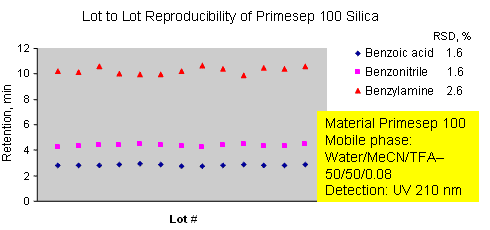| The main benefit of having more than one type of interaction on a column is the ability to provide separation even when one separation mode has failed. For example, while a typical reverse-phase column is unable to retain polar compounds without the addition of ion-pairing reagent, Primesep® columns with their ion-exchange retention separate wide range of polar compounds without any difficulty. Primesep® columns are designed with the understanding that proper inclusion, not elimination, of secondary interaction is a powerful tool in selectivity control, column stability, and separation reproducibility. Primesep® multi-step manufacturing process guarantees good reproducibility of retention of neutral, acidic and basic compounds. The plot below shows the consistency of performance achieved on 13 lots of the stationary phases synthesized from 3 different lots of silica gel during one year.
Every Primesep® column has a dual chemistry stationary phase with a hydrophobic long alkyl chain and an ionizable cationic or anionic embedded group. When the polar group bears a charge, it effectively shields any other less polar groups of the stationary phase. As a result, silanol groups, which cause unwanted interaction in many reverse-phase columns, are completely undetectable and do not affect the peak shape and selectivity. |

© SIELC Technologies. 2002 - 2026
Sign up to our newsletter
Contact
Address: 804 Seton Court, Wheeling, IL USA 60090
Tel: (847) 229-2629 | Fax: (847) 655-6079
Sales, Refund and Returns Policy
Email: mail@sielc.com | Sitemap
Host a Customized Seminar at Your Company
Delivering tailored seminars directly to your team.
